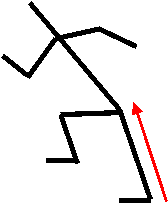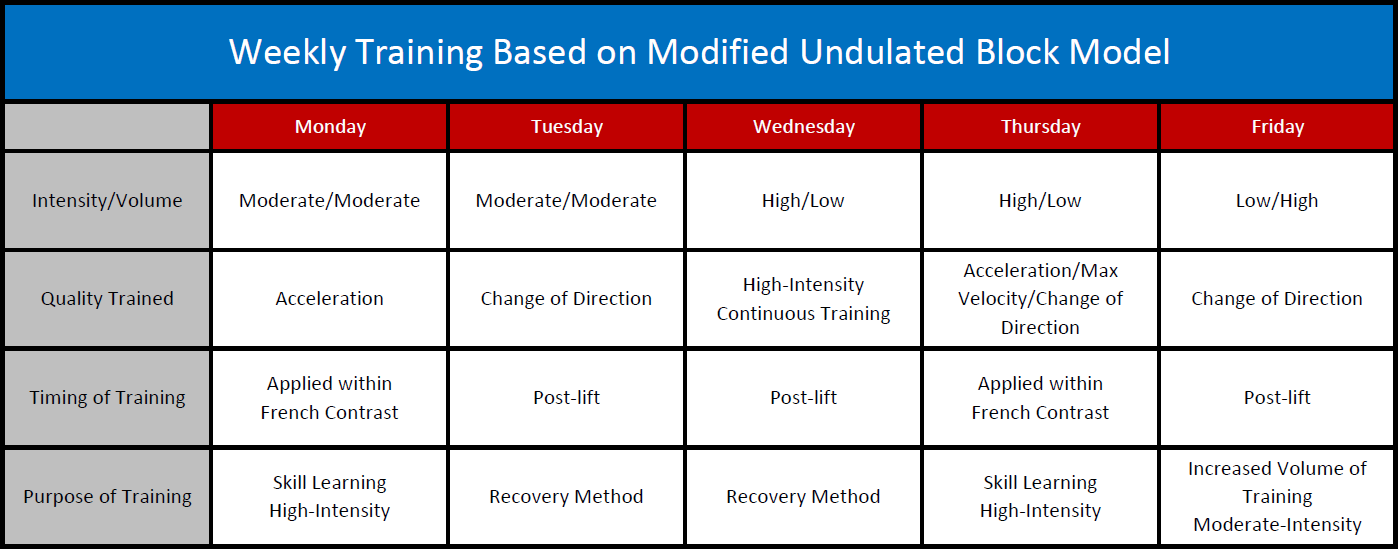
Implementation of Running Technique Training into The Triphasic Training Model
By: Cal Dietz, Matt Van Dyke, and Clayton Oyster
Coaches that have implemented Triphasic Training in the past, or those currently applying its means understand the high stress placed upon their training athletes. In many cases stressors experienced in Triphasic Training reach such levels that the addition of high-intensity running technique training, such as acceleration, max velocity, or change of direction is not possible without potentially causing overtraining. The proper addition of these sprinting technique programs leads to improved force production, efficiency of movement, and reduction of injury during sprinting, which results in improved performance in ground based performance sports. All coaches understand “speed kills,” but the proper addition of these running programs has not yet been addressed in regards to Triphasic Training.
The aim of this article is to provide examples and ideas of how to implement these speed technique programs successfully without causing an overtraining effect on athletes. Touches, or ground contacts, are the typical method to measure intensity of a running program. Keeping the number of touches within the desired stress range for each day is imperative to improving performance without causing overtraining. The nature of the design of Triphasic Training allows for some very interesting applications of these speed technique training methods, specifically within the French Contrast method and the undulated block model.
The French Contrast method utilizes training velocities right at, slightly faster, and slightly slower than the speeds seen in competition. Typically plyometric movements such as hurdle hops, accelerated band jumps, and weighted squat jumps are used, respectively, to fulfill the requirements of this velocity based training method. As touches in sprinting are also considered plyometric in nature, they can be applied within the training day to not only increase stress specificity, but also reduce the likelihood of injury due to over prescribing high-intensity movements. Movements programmed during the French Contrast block of training have the ability to be made specific to the desired technique improvements of the running phase being trained.
Before the specifics of this training can be discussed, it is important each coach knows and understands the training principles being used to train each of these three running qualities. Each of these qualities, acceleration, max velocity, and change of direction, must be trained in a specific manner as each requires a different set of skills athletes must learn.
Three Phases of Running in Athletics
Acceleration training is ultimately based around the ability to maintain a forward angle while keeping the hips from falling behind. This position, which is displayed in the graphic below, will look like a falling plank, with the body in a straight line from the extended back leg up through the hips to the neutral position head. By keeping the hips in proper position, power and transfer of force is optimized throughout the kinetic chain used in sprinting by allowing maximal knee drive to be achieved. Knee drive action during sprinting should work in a piston motion with the ball of the foot striking behind the hip at full extension. An understanding of simple biomechanics shows by striking the ground behind the hip, the athlete is propelled forward while the acceleration angle is maintained. Training of acceleration is associated typically with 10 yard bursts and is highly related to starting strength of the athlete. These short distance bursts are used to ensure acceleration is the only quality being focused on during the session. As an athlete improves their ability to transfer force into the ground, an appropriate angle can be maintained which maximizes the acceleration phase of running.
As described in the acceleration paragraph above, the ability to transfer high amounts of force into the ground allows the hips to be locked into a good position while “falling” forward into an acceleration angle. This angle training is crucial to maximizing knee drive, and thus increasing ground reaction forces. When the hips “break” force is lost by the increased needed vertical output to maintain the position. This leads to less force production and less distance being covered with each step. Elite sprinters can accelerate with a greater angle because they have learned the skill of applying more force to support that angle. A coach must be careful when coaching this angle specific training that the hip positioning of an athlete is not “breaking”. If the hips are breaking the athlete does not currently have the force producing capabilities to support running at that angle.
Proper positioning with “hips locked in” Improper position with “hips breaking"


Maximal velocity training is the ability to maintain proper posture and technique once the acceleration phase has been successfully completed. The ability of the foot to strike directly beneath the hip is of upmost importance to ensuring minimal breaking force is applied through the ground. Throughout technique work shin angle can be used to determine much of the force application direction. It is important that coaches realize the amount of time spent for most team sports in maximal velocity running is relatively small compared to the time spent in the acceleration and change of direction phases of running. Even though this skill is not used often it is important to not overlook the importance of its training. Teaching an athlete how to properly cycle while maintaining an upright posture and strike directly below the hip has the potential to make the difference on an explosive play in any game. Maximal speed is dictated not only by ground reaction forces, but by the ability to produce that force rapidly. It is important to realize speed and rate of force development are both learned qualities and must be trained appropriately to see the desired improvements in maximal speed.
An example of cycling the leg through to ensure foot strike is below the hip can be seen below. The understanding of shin angle and its correlation to force application direction is vital to cueing athletes through these first two phases of running.
Correct Technique: Incorrect Technique:
Less braking force is applied due to proper Braking force is applied due to poor cycling
cycling of leg, leads to propulsion forward of leg, leads to more deceleration


Change of direction training is improving the ability of athletes to decelerate, or absorb force as the come to a stop, and the reapply that absorbed force in the desired direction, all while utilizing safe mechanics to reduce the likelihood of injury. The eccentric method of training will work in conjunction to improve this ability as no athlete can produce what they cannot absorb in regards to force. Even with this specific training block in the weight room, it is important the skill of absorbing force is applied to the specific means each sport requires. These specific means can range from sprinting and changing direction, shuffling, cross-over running, etc. Ultimately the ability to control your body and the forces while decelerating, and then redirecting those forces through the use of proper edge work of the foot in the desired direction will determine the success of this ability in sport.
The French Contrast Method and the Three Phases of Running
The ability for these three phases of running to be applied in a smooth continuum throughout competition impacts athletic success directly. This ability can be clearly seen in almost any athletic movement or play. An athlete begins their movement (acceleration), must adjust according to the play of the opponent of play (change of direction), and, if a clear opportunity presents itself, must be able to open things up and run at full speed (maximum velocity). As a performance coach, the knowledge that each of these running qualities requires a separate set of skills leads to the understanding that they will all require different training methods to be improved. As explained above, the implementation of these specific skills in a high-velocity setting, while ensuring athletes avoid being overtrained should be the goal of all coaches. The French Contrast method allows for each of these running skills to be trained without the additional stress of separate training sessions.
The angle of acceleration and the ability to keep the hips “locked in” once that angle is achieved is the deciding factor in maximizing the accelerative abilities of each athlete. The ability to train using angle specific exercises just at, slightly faster, and slightly slower than the velocities seen in competition will lead to increased transfer of training in sport.
The ability to produce force rapidly becomes increasingly important as running velocity increases. This is due to ground contact times being dramatically reduced, particularly in elite sprinters. It is for this reason reactivity is focused on when this quality is being trained. The ability to produce high levels of force in the brief amount of time the foot is in contact with the ground is the ultimate determinant of maximal velocity running.
Absorbing high levels of force and the redirecting that force is imperative for improved change of direction in athletics. The proper use of edges is another vastly important skill in the application of force while changing directions in a high-velocity setting. The implementation of edge work and lateral movements can be incorporated within the French Contrast method to maximize this running based performance quality.
The chart below shows potential methods that can be applied to the three running phases found in athletics while maintaining the potentiating effects of the French Contrast method.

Implementation of Training Based on the Weekly Modified Undulated Model
The implementation of these high-intensity stressors must not only coincide with the volume needed for quality adaptation, but must also match the stress and times of training based on the modified undulated training system used in Triphasic Training. It is not only important these rules are followed closely, but that technique specific training is completed while athletes are fresh. For an article explaining the reasoning for the tactics on the optimization of skill learning click here. The example program shown in this article is based on a five day training model. Coaches must understand this is simply one example that we have implemented and that there are many ways to go about programming these running days into training. Training must always revolve around the needs of the team and the athletes being trained.
Monday – Acceleration day
Acceleration is a highly technical learned skill in running, for this reason the training of this quality is implemented early in the training week, while athletes are fresh and skill learning is optimal. It is also important to ensure quality of reps takes priority over quantity. Coaches can ensure the quality of each rep is high by allowing full recovery between the completed repetitions. The means of this acceleration quality can be trained within the French Contrast method as explained above. This not only increases specificity of the applied stressors, but also improves potentiation of the movement while also avoiding overtraining possibilities. As described above, the goal of acceleration training is to teach the “hips through” position while maintaining a proper acceleration angle. The knee drive in a piston fashion is also of critical importance as this allows the athlete to continually maintain balance and cover ground while the angle is maintained. Coaches should keep in mind the steeper the angle, the stronger the kinetic chain must be to maintain proper hip position. The exercises shows in the French Contrast method above are designed and utilized to specifically improve the desired qualities leading to improvements in the acceleration running phase.
Tuesday – C.O.D. Conditioning for Recovery
After the higher-intensity, quality, skill learning day required by acceleration training, it is important to ensure athletes are not over stimulated on concurrent days in regards to technique work. To ensure athletes are prepared for the next skill learning training, which will occur within the Thursday training session, a lower-intensity training session can be used to improve recovery from the previous day. The targeted quality of training will be change of direction and it will be completed after the lift. Different movement patterns can be used such as shuffling, carioca, cross-over running, back pedaling, etc. to accentuate the edge work involved in transferring force applied while changing directions. Although this method is completed with a generally lower-intensity, the cutting mechanics used when changing direction must remain constant with those used in high-velocity settings. This will prevent bad habits to be formed and reduce the likelihood of injury. A basic example of this training can be seen in Metabolic Injury Prevention Running. However, the times of each rep can be manipulated to match the specific time of Tuesday training.
Wednesday – High Intensity Continuous Training (HICT)
This training quality is a relatively new method that incorporates both anaerobic and aerobic qualities. HICT is completed after the Wednesday training session and functions, in this model, to enhance recovery after the high-intensity training day. This method of training can be completed while coinciding with the modified undulated training model as shorter, but intense, training times applied within the day as HICT incorporates short burst movements and then rest times of 3 seconds. HICT improves blood flow to tissue while also utilizing the high-threshold, type II, explosive muscle fibers that conventional aerobic training will not recruit. Clearly the use of this training can enhance recovery while preventing the explosive muscle fibers from becoming more aerobic in nature.
Thursday – Acceleration, Max Velocity, or C.O.D. High-Intensity Day
Training completed on a Thursday is very similar to that of the Monday session. Exercises specific to the desired quality will be completed during the French Contrast method to increase potentiation. Quality of each repetition is important again, but the set-up of Triphasic, through the use of small, active recovery methods between high-intensity exercises, allows for high-quality repetitions to be completed. The decision of which quality to be trained completely relies on the needs of the team, or individual athlete if you have the staff to support that specificity of training. The training of the qualities could also progress based on the block method. Acceleration could be trained early in the process as it is dictated by strength, with maximal velocity being trained in the later blocks as it relies much more on the reactive ability of the athlete. Change of direction can also be implemented on this day in a high-intensity manner is a coach deems necessary. We personally implement this training quality on Friday.
Friday – C.O.D. Volume Day
As stated above, we have implemented a change of direction day on Friday’s in a volume based manner. This method, along with the rest of the week, is set up to work along with the modified undulated training style used within Triphasic Training. It is important to continue to train proper deceleration patterns to maximally reduce potential injuries. Work on this day can be measured using heart rate monitors and should be completed around 70% of maximal heart rate of each individual. This not only allows volume of training to be accumulated but also adds stress to the athlete prior to the weekend recovery period.
The chart below shows just one possible tactic used to implement the training methods as described in the previous paragraphs. A performance coach must remember the purpose of each training quality within each training day and the timing of occurrence for the optimization of skill development.

Progression of Movements through the use of the Block Training Method
With the weekly set up of running shown above based on the modified undulated model, the final aspect a coach must consider is long term progression of exercises, with the ultimate goal of leading to increased performance. The ability to improve transfer of training, through the use of specific velocity based training protocols, becomes of increased importance as the competition approaches. Coaches familiar with the block training method used throughout Triphasic Training understand training is based on the residuals of each performance parameter. Strength of a movement is trained first within the above 80% block, then the same movement is trained within the range of 55 to 80% to maximize power, with the final block being completed training the same movement patterns but at an intensity of below 55% to increase specificity of training. The idea of training just faster, just at, and just slower than the speeds seen in the athletic event should be considered not only in the French Contrast method, but throughout the entire peaking block to continue to increase transfer of training, which leads to improvements in performance.

Understand these programs are designed for the collegiate level athletes we, as performance coaches, deal with on a daily basis. These are not designed specifically from world-class speed coaches dealing with elite track and field athletes. All coaches must realize these training plans can be adjusted to fit the specific needs of each group of athletes being trained. These adjustments allow great variability in training all based around the compatible tactics utilized to optimize training and performance between the weight room and running technique requirements needed in athletics.